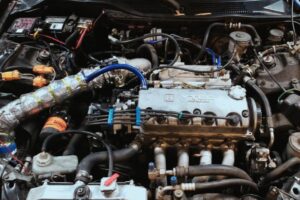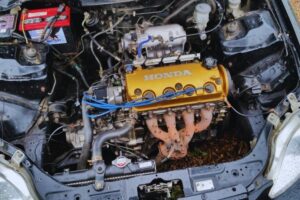Hemi engines are a top choice among engine enthusiasts. However, just like any other motor, encountering Hemi engine problems is also inescapable. So, what are the common Dodge 5.7 Hemi problems encountered?
The most common Dodge 5.7 Hemi problems encountered involve high torque curves, ram weight, dipstick tube sludge and water inside the oil cap, and Hemi tick. These Dodge 5.7 Hemi issues are not unusual, and knowing the causes will allow you to apply appropriate solutions.
Read on to learn more about Dodge 5.7 Hemi issues, including their causes and solutions.
5.7 Hemi Problems [Dodge 5.7 Hemi Causes and Solutions]

The most common Dodge 5.7 Hemi problems include high torque curves and ram weight, dipstick tube sludge, water inside the oil cap, and Hemi tick. Knowing the causes of these engine issues will allow you to apply proper solutions.
In this article, we will talk about the following Dodge 5.7 Hemi problems:
- Overheating
- Poor Emission Control
- Lifter Roller Issues
- Faulty Exhaust Manifold Bolts
- Misfires
- Engine Tick
- Multi Displacement System (MDS)
1. Overheating
Overheating may occur because the Hemi engine’s compulsion chamber does not have adequate space to cool down efficiently. The small space prevents enough air from circulating, which can result in overheating. At the same time, an idle engine also tends to overheat during the summer season.
2. Poor Emission Control
The emission control system is an essential part of every vehicle. It limits the toxic gases released from the engine and other components. Initially, the Hemi 5.7 engine had poor results when it came to emission testing.
In 2009, however, the Hemi engine was upgraded. The Hemi 5.7 Eagle was introduced to address problems involving fuel economy, emissions, and performance.
3. Lifter Roller Issues
The lifter roller symptoms associated with the 5.7 Hemi engine include Check Engine Light, misfires, and ticking. As soon as you notice these symptoms, make sure to have your engine checked as soon as possible.
This is because problems concerning lifter rollers can be challenging to diagnose, so you have to be mindful of the symptoms. Don’t wait until your engine problems worsen.
4. Faulty Exhaust Manifold Bolts
If your 5.7 Hemi engine has faulty exhaust manifold bolts, the initial symptom would be a ticking noise. Another symptom is a wear-out leak. If it worsens, you will most likely encounter engine power loss.
Exhaust Manifolds Are Made of Iron Metals
The exhaust manifolds of this engine are made of iron metals. During cooling and heating cycles, these metals contract and expand. While the expansion is a natural occurrence, the bolts can eventually experience too much tension. There’s a tendency to stretch beyond their capacity, which, unfortunately, can result in engine failure.
Check the Warranty
In case you encounter faulty exhaust manifold bolts, check if the warranty still covers them. If so, you can coordinate with a Hemi engine dealer and have your engine problem fixed without any fee.
If it’s not under warranty, it is possible to have it fixed on your own as it is not that complicated. But in case you are in doubt, you can always seek assistance from a professional.
5. Misfires
Symptom More Than a Problem
Misfires are not a common 5.7 Hemi engine issue. However, it is associated with several common engine issues. In essence, misfires are considered a symptom more than a problem. So, in case you encounter this, you don’t have to look for any other symptom as it is already a symptom in itself.
Air-Fuel Mixture Does Not Burn Enough
This symptom happens if the air-fuel mixture does not burn enough in the burning chamber. It then results in jerking off the engine, power loss, and increased fuel consumption.
Lack of Maintenance
In some cases, misfires happen due to a lack of maintenance. Sadly, this is one most common causes of misfires. Without proper care, engine parts will wear out sooner than expected. If you continue to ignore this, it will most likely result in misfires.
Other Causes
There are, however, other causes of misfires. Some of these involve faulty ignition coils, lifter rollers, and injectors. So, make sure to subject your vehicle to regular maintenance.
6. Engine Tick
If you experience an engine tick, expect some people to say that it is normal and will not impact your engine. Maybe they are correct, but they can be incorrect too. In which case, it is always best not to ignore anything that your vehicle experiences out of the ordinary.
Affects the 5.7 Hemi Engine’s Lifespan
Engine ticking can affect the lifespan of your 5.7 Hemi engine. If worst comes to worst, you might have to replace the entire engine of your vehicle.
Faulty Exhaust Manifold
There are several reasons for engine ticking to occur. It can be because your engine has a faulty exhaust manifold bolt or faulty lifters. Also, it can be because the engine’s roller lifter is seized.
Damaged Lifter
In most cases, engine ticking results from a faulty lifter and is considered one of the most serious reasons, if not the most.
This occurs when the roller lifters do not get proper oil flow. In which case, it can lead to a seizure. The lifter then gets into contact with the camshaft lobes, which causes the ticking sound.
That’s why you must not ignore it once you hear ticking sounds. Allow a professional to check your vehicle so he can properly diagnose it. This will prevent your engine from any further damage.
7. Multi Displacement System (MDS)
Shuts Down the Cylinders
The Multi-Displacement System, or MDS, is utilized by the Hemi engine to shut down the cylinders. This excellent technology allows improvement in terms of fuel efficiency and emissions.
Displacement Engine Technology
MDS is a displacement engine technology introduced by Chrysler. Since 2006, it has been incorporated in all Hemi engines. It is, however, unavailable in automobiles that have a manual gearbox.
There is no official confirmation that MDS harms engines. For all we know, this can only be speculation. Many drivers believe in its advantages.
However, some claim that MDS affects engine performance. While their vehicles nonetheless work well, they claim that something does not feel natural when driving.
Some Studies Indicate That MDS Harms the Engine
It seems that no specific issues indicate that MDS has a direct negative impact on Hemi engines. But there have been studies showing that MDS tends to harm the engine and affect its lifespan.
Suffice to say that MDS is not a serious Dodge 5.7 Hemi problem. Nonetheless, it is not something that we should ignore too.
Again, what are the most common 5.7 Hemi problems? The 5.7 Hemi Engine is susceptible to engine tick issues, exhaust manifold bolts, high torque curves, ram weight, dipstick tube sludge, water inside the oil cap. When you know which of these issues your engine has, you’ll quickly solve your engine problem.
Solution to 5.7 Hemi Engine Problems

Perform an Engine Test
The first thing to do is to perform an engine test. This will allow you to determine the quality or state of your engine.
Engine Oil Issue
If the camshaft and the lifter wheel score 57 RC, you can conclude that there is an issue with engine oil. Hemi is known for its sensitivity in terms of oil conditions.
Chrysler Recommends Using 5W-20 Oil for the Hemi Engine
That’s why Chrysler highly recommends using 5W-20 oil for the Hemi engine. This oil has a thin viscosity. In which case, the engine can communicate with the cam shifter easily. This will enable your engine to maintain its excellent condition and deliver maximum performance for an extended period.
Suffice to say that you will prevent your Hemi engine from encountering problems with proper maintenance and handling.
About the 5.7 Hemi Engine
As earlier mentioned, the Hemi engine was developed and introduced by Chrysler. It is an internationally known hemispherical-shaped engine that has a lot of impressive features. With regular engines, the piston features a flat top. At the same time, the Hemi engines have a round-shaped piston.
Hemi engines have a narrow surface area. It is thinner compared to other automotive engines. This results in improved heating and burning of fuel.
There have been several Hemi versions released on the global market since 1951. Chrysler introduced the third-generation 5.7 L Hemi in 2002. The 5.7 Hemi engine powers many Dodge models, including:
- Challenger R/T
- Charger R/T
- Magnum R/T
- Durango
Is the Hemi a Good Engine
If you are curious whether the Hemi is a good engine or not, the answer is yes, it is a great engine. Despite the Hemi issues that we know of, it is still known for its durability and reliability. Undoubtedly, this engine has robust features.
345 Hemi Update (5.7 Eagle)

The manufacturers made revisions to the 5.7 Hemi engine to address emissions, fuel efficiency, and performance issues. Then, they introduced the revised engine in 2009 as the 5.7 Eagle engine.
Upgrades Done
Some of the upgrades made involve the following:
- MDS,
- Intake manifolds,
- Cylinder head, and
- Variable camshaft timing.
Variable Camshaft Timing
The Variable Camshaft Timing refers to Chrysler’s variable valve timing, enabling the engine to retard or advance cam timing. Thus, It will allow you to experience maximum performance at all RPMs.
While the intake manifolds got some upgrades, too, the 5.7 Eagle requires specific manifold designs on certain models.
Implementation of Multi-displacement System Technology
Another upgrade is Chrysler’s implementation of the multi-displacement system technology. It enables the engine to shut down four cylinders in certain scenarios. This successfully enhances fuel efficiency and emissions.
5.7 Hemi Reliability
Of course, after discussing several Dodge 5.7 Hemi issues, you are most likely wondering about how reliable this engine is. The answer is, it is very reliable. Once you weigh out the pros and cons of this engine, you will realize that it is nonetheless a very dependable engine.
This engine has powered several Chrysler flagship cars, and those who own them have nothing but praises about their solid engine.
The issues encountered with the 5.7 Hemi engine can also be encountered with other engines. Again, it all boils down to proper handling and maintenance.
Conclusion – 5.7 Hemi Problems
Some of the most common Dodge 5.7 Hemi problems encountered include high torque curves and ram weight. It also has such issues as dipstick tube sludge and water inside the oil cap and Hemi tick. Knowing the causes of these engine issues will allow you to apply proper solutions.
Dodge 5.7 Hemi issues may include overheating, poor emission control, and faulty lifter rollers. You may also encounter faulty exhaust manifold bolts, misfires, engine ticks, and multi-displacement system issues.
Most of those Hemi engine issues are also encountered with other types of engines. So, we can’t single out Hemi when it comes to this.
Again, it all boils down to how we take care of our vehicle as a whole. If we always subject our vehicles to proper handling and maintenance, we can prevent engine problems. At the same time, we can even prolong the lifespan of the engine.
Related reading:
What Does Hemi Mean? What Is a Hemi Engine?
Interference Engine List [and Non-Interference Engine List]

![Ford 6.2 Engine Problems [5 Most Common and How to Fix] ford 6.2 engine problems](https://roadsumo.com/wp-content/uploads/2021/06/ford-6.2-engine-problems-150x150.jpg)


![Why Is My ABS Light On? [7 Common Reasons] why is my abs light on](https://roadsumo.com/wp-content/uploads/2022/04/why-is-my-ABS-light-on-150x150.jpg)
![Most Reliable Sports Cars in the World [Top 10] most reliable sports cars in the world](https://roadsumo.com/wp-content/uploads/2022/10/most-reliable-sports-cars-in-the-world-150x150.jpg)
![Most Reliable Luxury Cars [Top 10] most reliable luxury cars](https://roadsumo.com/wp-content/uploads/2022/10/most-reliable-luxury-cars-150x150.jpg)


